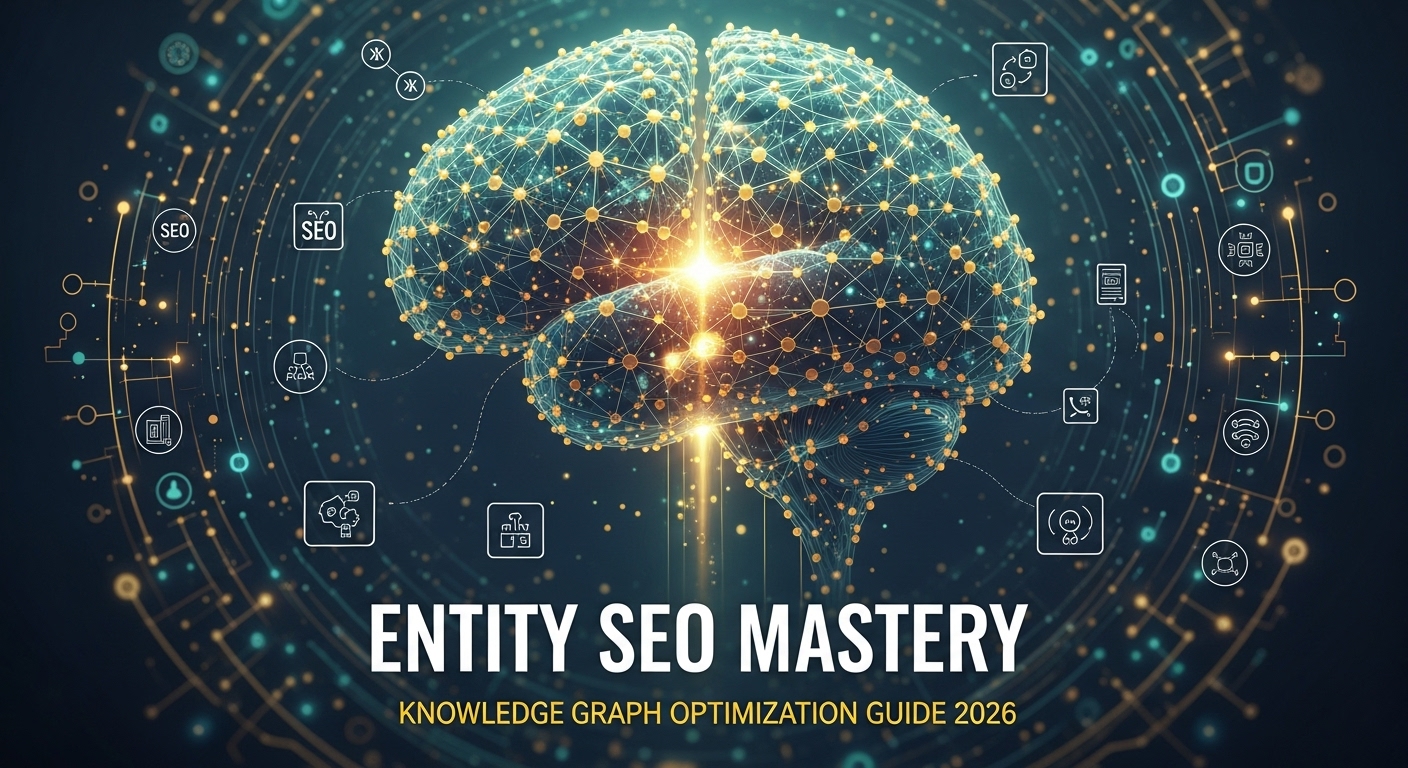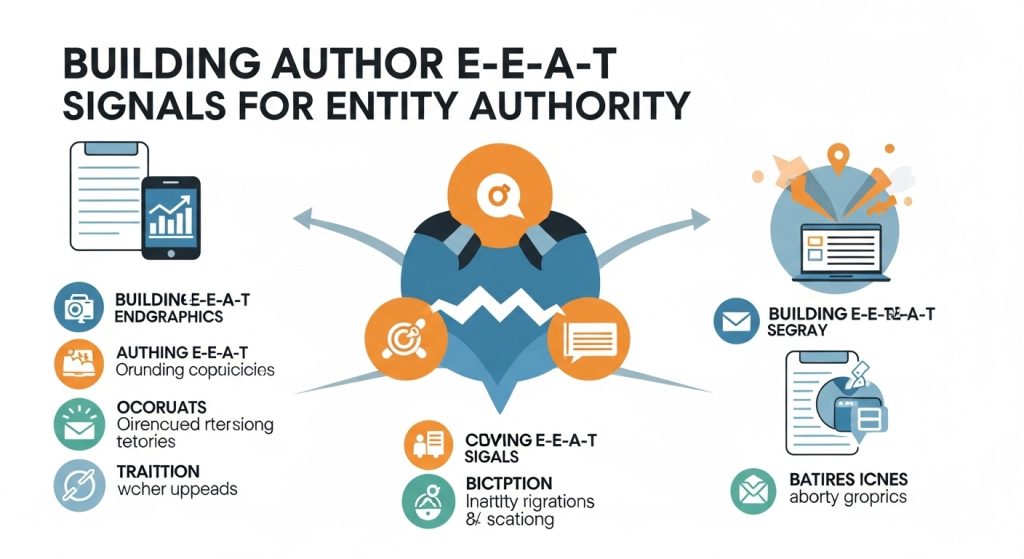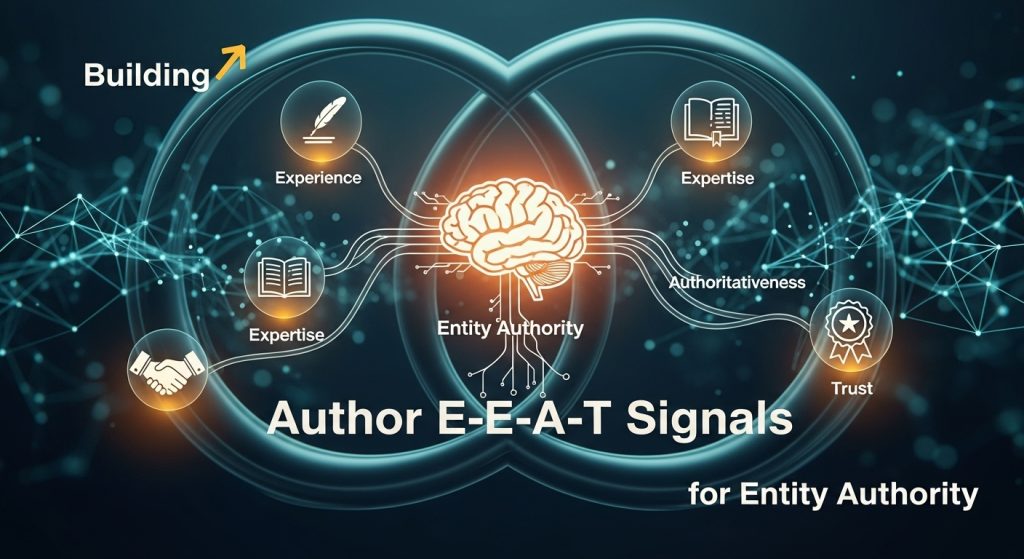
Entity SEO Mastery: Knowledge Graph Optimization Guide 2026
Entity SEO Mastery: Knowledge Graph Optimization Guide 2026
The Paradigm Shift: Why Entity SEO Is Replacing Keywords
Search engines no longer see your content as collections of keywords. They understand entities—people, places, things, concepts—and the relationships between them. This fundamental shift from string matching to semantic understanding represents the most significant evolution in search since Google’s inception.
Entity SEO recognizes that search engines have become knowledge engines. Google’s Knowledge Graph contains billions of entities and trillions of connections. When users search, algorithms don’t just match words—they interpret intent, understand context, and deliver information based on entity relationships and semantic relevance.
Traditional keyword optimization focused on matching user queries with exact phrases or variations. Entity-based search optimization focuses on establishing your content, brand, and expertise as recognized entities within specific knowledge domains. This approach future-proofs your SEO strategy against algorithm updates while building sustainable topical authority.
ALSO, READ The Future of SEO in the Age of AI Search (2026 Edition)
Understanding and implementing entity SEO before 2026 isn’t optional—it’s imperative. As search grows more sophisticated, content optimized only for keywords will become invisible while entity-optimized content dominates search results, AI overviews, and voice assistant responses.
Understanding Entities: The Building Blocks of Semantic Search
What Are Entities in SEO?
Entities are uniquely identifiable things or concepts with distinct existence. Unlike keywords, which are merely strings of text, entities carry meaning, attributes, and relationships. The entity “Apple” as a company differs from “apple” the fruit, and search engines understand this distinction through contextual signals.
Entities include tangible objects like products and locations, people including individuals and organizations, abstract concepts like theories and methodologies, events such as conferences and historical moments, and attributes like colors, sizes, and characteristics. Each entity possesses properties that define it and relationships that connect it to other entities.
When you optimize for entities, you’re helping search engines understand not just what words appear on your page, but what real-world things you’re discussing, how they relate to each other, and why your content represents authoritative information about these entities.
How Knowledge Graphs Work
Knowledge graphs are massive databases that map entities and their relationships. Google’s Knowledge Graph launched in 2012 and has grown exponentially. It powers featured snippets, knowledge panels, and AI-generated search responses.
The graph structure connects entities through relationship edges. “Microsoft” connects to “Bill Gates” through a “founded by” relationship. “Seattle” connects to “Microsoft” through a “headquarters location” relationship. These connections form a web of understanding that mirrors human knowledge structures.
When you search for “who founded Microsoft,” Google doesn’t search for pages containing those exact words. It queries the Knowledge Graph for the entity “Microsoft,” identifies the “founded by” relationship, and returns “Bill Gates” as the answer. Your content influences Knowledge Graph understanding when it provides clear, authoritative information about entities and their relationships.
The Evolution from Keywords to Semantic Understanding
The keyword era treated search as pattern matching. Content creators stuffed pages with target phrases, and algorithms ranked based on keyword frequency, placement, and backlink anchor text. This system was gameable and often delivered poor user experiences.
Semantic search understands meaning, context, and intent. The query “apple stock” triggers financial information because semantic analysis identifies “stock” in the financial context, recognizing the query refers to Apple Inc., not fruit inventory.
ALSO, READ Future Trends in SEO and Web Infrastructure (2026–2030)
Natural Language Processing advances enabled this evolution. Technologies like BERT, MUM, and subsequent models allow search engines to understand context, nuance, ambiguity, and conversational language patterns. These systems recognize entity mentions even when exact names don’t appear, understand pronoun references, and interpret implied relationships.
Building Your Entity Foundation: From Unknown to Recognized
Establishing Your Brand as an Entity
Before optimizing content for entity relationships, you must establish your own brand, business, or personal identity as a recognized entity within search systems. This foundation makes all subsequent entity SEO efforts exponentially more effective.
Entity establishment begins with consistency. Your Name, Address, and Phone number must remain identical across all platforms—website, social media, directories, citations. Inconsistencies confuse entity recognition systems. If your business appears as “ABC Marketing Inc.” on your website but “ABC Marketing” on Google Business Profile, search engines struggle to confirm you’re the same entity.
Structured data provides explicit entity definitions. Implement Organization schema on your homepage declaring your entity type, official name, logo, social profiles, contact information, and founding date. This structured data tells search engines exactly what entity you represent.
Wikipedia presence significantly boosts entity recognition. While not every business qualifies for Wikipedia inclusion, those meeting notability guidelines should pursue this. Wikipedia serves as a primary source for Knowledge Graph data. If you’re notable enough for Wikipedia, creating and maintaining an accurate page powerfully establishes your entity.
Wikidata entries complement Wikipedia presence. Wikidata is the structured database behind Wikipedia, containing entity information in machine-readable format. Even without Wikipedia articles, some entities can establish Wikidata entries that inform Knowledge Graph understanding.
Knowledge panel acquisition signals entity recognition. When searching your brand name produces a knowledge panel with information about your business, you’ve achieved entity status. These panels pull from multiple sources including your website’s structured data, Google Business Profile, social media, and authoritative third-party sources.
Creating an Entity Profile Across Platforms
Entity presence extends beyond your website. Search engines verify entity legitimacy through cross-platform presence and consistency. Fragmented or contradictory information weakens entity signals.
Claim and optimize your Google Business Profile completely. Include accurate business information, service descriptions, high-quality images, regular posts, and prompt review responses. This profile directly feeds Knowledge Graph data for local entities.
Maintain active, verified social media profiles on major platforms. LinkedIn, Twitter, Facebook, Instagram, and industry-specific platforms establish social proof of entity existence. Verification badges on these platforms strengthen entity legitimacy signals.
Secure complete branded profiles on professional platforms like Crunchbase for businesses, ORCID for researchers and academics, professional organization directories for credentialed experts, and industry-specific listing sites relevant to your domain.
Author profiles for content creators require special attention. Every article author should have detailed author pages on your site including professional headshots, comprehensive biographies, credentials and qualifications, links to social profiles, and links to all authored content. These author pages should implement Person schema markup defining the author as an entity.
Structured Data Implementation for Entity Recognition
Structured data transforms implicit information into explicit entity declarations. While search engines grow increasingly sophisticated at extracting meaning from unstructured text, structured data removes ambiguity and directly communicates entity information.
Schema.org vocabulary provides standardized structured data types. JSON-LD format is preferred by Google and easiest to implement—it lives in a script tag rather than cluttering HTML markup.
For organizations, implement comprehensive Organization schema including legal name, alternate names, logo, address, contact points, social profiles, founding date, founders, and parent/subsidiary relationships. Place this schema on your homepage and maintain it consistently.
For individuals, Person schema defines people entities with name, job title, affiliation, image, social profiles, educational background, awards, and contact information. Every author, executive, or key person mentioned on your site deserves person schema.
Product entities require Product schema with name, description, brand, SKU, image, price, availability, ratings, and reviews. This structured data helps search engines understand your products as distinct entities with defined attributes.
Local Business schema is essential for physical locations, including business type, service area, opening hours, price range, accepted payments, and geographic coordinates. Multiple locations require individual Local Business schema for each.
ALSO, READ How to Build a Security-First Website: From Planning to Launch
Article schema marks content pieces as entities with headline, author, publish date, modify date, image, and publisher information. This helps search engines understand individual content pieces and their relationships to author and publisher entities.
Breadcrumb schema defines site structure and content relationships, helping search engines understand entity hierarchies within your site architecture.
Developing Topical Authority Through Semantic Clusters
The Hub-and-Spoke Content Model
Topical authority requires comprehensive coverage of subject domains. Isolated articles on random topics don’t establish authority. Semantic clusters—organized groups of interrelated content—demonstrate deep expertise.
The hub-and-spoke model creates topical authority architecture. Pillar content serves as the hub—comprehensive, in-depth coverage of broad topics. Spoke content includes detailed articles addressing specific subtopics, questions, and use cases related to the pillar topic.
Each cluster focuses on a primary entity or concept. For a digital marketing agency, clusters might center on entities like “content marketing,” “SEO,” “PPC advertising,” and “social media marketing.” The content marketing cluster would include a pillar page comprehensively covering content marketing plus spoke articles on content strategy development, blog writing best practices, video content creation, content distribution channels, and content performance measurement.
Internal linking connects spokes to hubs and related spokes to each other. This linking structure signals to search engines the relationships between content pieces and reinforces your expertise across the entire topic cluster.
Entity mentions within clusters should be consistent and clearly defined at first reference. When introducing entities in content, provide context that helps both readers and search algorithms understand what entity you’re discussing and its relevance to the topic.
Keyword Research Evolves Into Topic Research
Traditional keyword research identified high-volume search terms to target. Entity-focused topic research maps entire knowledge domains to understand all entities, relationships, and questions within a subject area.
Begin with core entities relevant to your expertise. List primary topics, concepts, products, services, methodologies, and industry terms that define your domain. These become your entity targets.
For each core entity, identify related entities. What concepts connect to your primary topics? What questions do people ask? What subtopics exist? What complementary or competing entities should you address?
Topic modeling tools help discover semantic relationships. Tools like MarketMuse, Clearscope, and Surfer SEO analyze top-ranking content to identify entities and concepts that thorough coverage should include.
People Also Ask boxes reveal entity-related questions. When you search primary entities, PAA boxes show related queries that real users ask. These questions reveal entity relationships and content gaps to address.
Related searches at the bottom of search results pages suggest connected entities and topics. These variations show how users explore topics and what related entities they seek information about.
Competitor content analysis reveals their entity coverage. Examine competitors’ content clusters to identify entities they cover thoroughly and gaps in their coverage you can exploit.
Entity extraction tools can analyze competitor content to identify which entities they mention frequently, providing insight into their topical focus and authority areas.
Creating Comprehensive Entity-Focused Content
Content optimized for entities differs fundamentally from keyword-optimized content. Instead of forcing keywords into content unnaturally, you explore entities thoroughly, explain relationships clearly, and provide comprehensive entity context.
Define entities clearly at first mention. When introducing an entity, explain what it is, why it matters, and how it relates to your topic. This clarity benefits both human readers and machine comprehension.
Use consistent entity naming throughout content. If you introduce “Search Engine Optimization (SEO)” at first mention, continue using “SEO” consistently rather than alternating between variations. Consistency helps algorithms track entity references.
Explain entity relationships explicitly. Don’t just mention related entities—explain how they connect. “SEO and content marketing intersect because high-quality content attracts natural backlinks, which improve search rankings” explains the relationship between two entities.
Include entity attributes and properties. When discussing entities, mention relevant attributes. For a product entity, include price, dimensions, materials, use cases, and alternatives. For a person entity, include credentials, affiliations, notable achievements, and areas of expertise.
Link internally to other content about related entities. When mentioning entities covered elsewhere on your site, link to that content. This reinforces entity relationships and guides both users and crawlers through your knowledge structure.
Use structured content formats that make entity relationships explicit. Comparison tables, process diagrams, relationship maps, and category taxonomies visually represent entity connections in ways that both enhance user experience and provide clear semantic signals.
Schema Markup Mastery: Speaking Search Engine Language
Essential Schema Types for Entity SEO
Schema markup provides the most direct method for communicating entity information to search engines. While search algorithms extract meaning from unstructured content, schema removes ambiguity by explicitly declaring entity types, attributes, and relationships.
Organization schema defines business entities. At minimum, include type (Organization, Corporation, LocalBusiness, etc.), name, logo, URL, same as (social profile URLs), contact point (phone, email), and address. Enhanced implementations include founder, founding date, number of employees, and parent organization.
Person schema defines individual entities. Essential properties include name, image, job title, works for (linking to organization entity), same as (social profiles), and description. Additional properties like education, awards, knows (connecting to other person entities), and colleague strengthen entity definition.
WebSite schema declares your site as an entity with name, URL, and potential action (defining your site search function). This schema enables sitelinks search box in search results.
Article schema transforms content into entities with headline, author (linking to person entity), publisher (linking to organization entity), date published, date modified, image, and article body. This connects content entities to author and publisher entities.
BreadcrumbList schema defines navigational hierarchy, helping search engines understand content relationships and site structure. Each breadcrumb item becomes a list element with position, name, and URL.
HowTo schema structures instructional content with steps, tools, and supplies as distinct elements. This explicit structure makes instructions easily extractable for featured snippets and AI overviews.
FAQ schema marks question-and-answer pairs, making content eligible for FAQ rich results and improving discoverability for question-based queries.
Product schema defines product entities with name, image, description, brand, SKU, offers (price, availability), aggregate Rating, and review. This comprehensive product definition helps products appear in shopping results and rich snippets.
ALSO, READ The Ultimate Technical SEO Playbook for 2026 and Beyond
Review schema marks individual reviews with rating value, author, and review body, establishing credibility through structured feedback.
Implementing Advanced Schema Relationships
Basic schema implementation defines individual entities. Advanced implementation expresses relationships between entities, creating a local knowledge graph on your site that mirrors and contributes to broader knowledge graphs.
The “author” property in Article schema creates person-to-content relationships. Implementing this connection tells search engines which person entity created which content entity. Consistent author attribution across multiple quality articles builds author entity authority.
The “publisher” property connects content to organizational entities. Every article should declare its publisher using Organization schema, establishing brand authority for content production.
The “about” and “mentions” properties in Article schema explicitly declare which entities the content discusses. If you write an article about search engine optimization mentioning Google, Bing, and specific SEO tools, these properties formally declare those entity relationships.
The “isPartOf” property connects content entities to larger collections. Articles can declare they’re part of blog entities or specific content series, establishing hierarchical entity relationships.
The “worksFor” property in Person schema connects individuals to organizations. When author pages declare which organization authors work for, this strengthens both author and organization entity credibility.
The “alumni of” property connects people to educational institutions, establishing credential entity relationships that support E-E-A-T signals.
The “knows” property creates person-to-person entity connections. When experts know other recognized experts, declaring these relationships builds entity networks that enhance credibility.
Product schema can include “brand,” connecting products to brand entities, and “manufacturer,” distinguishing between brand and production entities.
Validating and Testing Schema Implementation
Implementing schema markup incorrectly provides no benefit and may cause errors. Thorough validation ensures markup functions as intended.
Google’s Rich Results Test validates whether your structured data makes content eligible for rich search results. Enter URLs or code snippets to see which rich result types your markup supports and identify any errors or warnings.
Schema Markup Validator checks markup correctness against schema.org specifications. This tool identifies syntax errors, missing required properties, and incorrect property values.
Google Search Console’s Enhancements reports show which structured data types Google detects on your site, how many pages contain each type, and any errors or warnings. Monitor these reports regularly to catch implementation issues.
Manual inspection of search results reveals whether schema achieves desired outcomes. Search for your brand, articles, and products to see if knowledge panels, rich snippets, or enhanced search results appear.
Testing different schema implementations on staging environments before deploying to production prevents errors from affecting live search performance. Create test pages with schema variations to identify which implementations achieve optimal results.
Regular schema audits ensure markup remains current as schema.org specifications evolve. New schema types and properties emerge regularly. Periodic reviews identify opportunities to enhance markup with newly available options.
Building Author E-E-A-T Signals for Entity Authority

Experience Signals in Author Profiles
Google’s updated E-E-A-T guidelines emphasize Experience as a first-party qualifier of expertise. Demonstrating genuine, first-hand experience with topics you write about has become non-negotiable for content authority.
Author pages must showcase real experience. Generic bios stating “John has 10 years of marketing experience” provide minimal value. Specific experience demonstrations work: “John led the content strategy for three SaaS companies that achieved 300% organic traffic growth, developing the framework detailed in his articles.”
First-person case studies embedded in content demonstrate experience directly. Rather than writing “companies should implement content clusters,” experienced authors write “when we implemented content clusters for our B2B client, we saw 156% traffic increase in 90 days. Here’s our exact process.”
Original data and research signal first-hand experience. Authors who conduct surveys, analyze proprietary data, test methodologies, and share original findings demonstrate experiential authority that AI-generated or derivative content cannot replicate.
Visual proof of experience reinforces credibility. Screenshots from actual projects, photos from industry events, video testimonials from clients or colleagues, and portfolio examples provide tangible evidence of experience claims.
Behind-the-scenes content showing process, methodology, or work environment humanizes authors and proves they actually do what they teach. Video of your workspace, tools you use daily, or live implementation of techniques demonstrates authenticity.
Expertise Signals Through Credentials and Recognition
Expertise requires demonstrable knowledge and skill within specific domains. Multiple signals combine to establish expert entity status.
Formal credentials provide foundational expertise signals. Academic degrees, professional certifications, licenses, and specialized training establish baseline qualifications. Author profiles should list relevant credentials with issuing institutions and dates.
Publications and speaking engagements demonstrate recognized expertise. Authors who’ve published books, contributed to industry publications, spoken at conferences, or appeared on podcasts show their expertise has been validated by third parties.
Professional affiliations signal industry recognition. Membership in professional organizations, especially leadership positions or committee participation, indicates peer recognition of expertise.
Awards and honors provide third-party validation. Industry awards, recognition programs, or competitive achievements establish expertise through external evaluation.
Media mentions and interviews show others value your expertise enough to seek your perspective. Track and showcase media appearances on author pages.
Peer recognition through collaboration with other recognized experts builds credibility through association. Co-authored content, joint webinars, or quoted references from respected experts enhance your expert entity status.
Authoritativeness Through Consistent Content Production
Authority develops through sustained demonstration of expertise over time. One-off content rarely establishes authority. Consistent, high-quality content production across related topics builds authoritative entity recognition.
Prolific, focused authorship within specific domains signals authority. Authors should concentrate content production within defined expertise areas rather than writing scattered content across unrelated topics. Deep coverage of narrow domains outperforms shallow coverage of broad areas.
ALSO, READ How SMEs Achieved SEO Growth with Smart Security
Content update cadence matters. Regular publication demonstrates ongoing engagement with your domain. Search engines recognize authors who consistently contribute fresh perspectives and updated information as more authoritative than those with sporadic publication.
Evergreen content maintenance shows authority through sustained accuracy. Returning to older content to update statistics, refresh examples, and incorporate new developments demonstrates commitment to maintaining authoritative resources.
Author content clusters mirror topical authority clusters. When individual authors develop comprehensive coverage of specific entities or topics through multiple related articles, it establishes them as go-to authorities on those specific subjects.
Cross-platform content consistency reinforces authority. Authors whose expertise appears across multiple reputable platforms—their company blog, guest posts on industry sites, social media insights—demonstrate broader recognized authority than those visible on single platforms.
Trust Signals That Cement Entity Credibility
Trust represents the culmination of experience, expertise, and authoritativeness signals. Multiple factors contribute to trustworthy entity perception.
Transparency about author identity and qualifications builds trust. Real photos, complete biographies, contact information, and professional background details create accountability that anonymous or pseudonymous authors lack.
Clear editorial processes and fact-checking procedures demonstrate content reliability. Pages explaining review processes, editorial standards, and accuracy commitments signal trustworthiness to both users and search algorithms.
Source citations and reference links show information derives from reliable sources. Content that cites authoritative sources, links to original research, and acknowledges information origins demonstrates intellectual honesty that builds trust.
Correction and update policies prove commitment to accuracy. Transparent acknowledgment of errors, clear documentation of significant content updates, and honest communication when understanding evolves demonstrate trustworthiness.
User reviews and testimonials provide social proof of trustworthiness. Authentic reviews, case study results, and client testimonials offer third-party validation that enhances trust signals.
Security and privacy practices affect trust. HTTPS encryption, clear privacy policies, transparent data handling, and security certifications contribute to overall trustworthiness assessment.
Professional design and user experience signal legitimacy. While cosmetic, professional design, clear navigation, fast loading, mobile optimization, and polished presentation contribute to trust perceptions that algorithms factor into entity evaluation.
Linking Strategies for Entity Relationship Building
Internal Linking as Entity Relationship Mapping
Internal links serve dual purposes: they guide users through content and inform search engines about entity relationships within your content ecosystem. Strategic internal linking architecture amplifies entity SEO effectiveness.
Hub-and-spoke linking connects cluster content. Pillar pages should link to all spoke articles within their cluster. Spoke articles should link back to the hub and to related spokes. This creates clear entity relationship maps that search algorithms easily understand.

Contextual internal linking within content body reinforces entity connections. When discussing related entities, link to content that explores those entities in depth. These contextual links carry more semantic weight than navigational links.
Anchor text for internal links should clearly describe the linked content and entity. Descriptive anchor text like “our guide to semantic search optimization” provides more entity context than generic “click here” links.
Consistent linking to author pages from every authored article strengthens author entity recognition. Every article byline should link to the comprehensive author page, reinforcing the author-content entity relationship.
Orphan pages—content with no internal links pointing to it—receive minimal entity recognition. Content audits should identify orphaned pages and integrate them into internal linking structures.
Link depth affects entity importance signals. Content requiring many clicks from the homepage appears less important. Strategic internal linking should place important entity-focused content within 2-3 clicks of the homepage.
External Linking to Authoritative Entity Sources
Outbound links to authoritative sources strengthen your content’s credibility and provide entity context through association.
Link to primary sources and original research when citing information. Connecting your content to recognized authoritative entities through citations enhances your trustworthiness signals.
Wikipedia links provide explicit entity context. When mentioning entities with Wikipedia pages, linking to them helps search engines verify entity identity and understand relationships.
Official entity websites deserve links. When discussing organizations, products, or people with official web presence, linking to their primary digital properties reinforces entity accuracy.
Academic and research institution links boost credibility in specialized domains. Content discussing scientific, medical, technical, or academic topics should link to peer-reviewed sources and institutional research.
Industry authority links demonstrate you’re engaged with recognized leaders. Linking to thought leaders, established publications, and respected organizations within your industry signals you’re part of the authoritative conversation.
Government and educational institution links carry high trust signals. When relevant, linking to .gov and .edu domains enhances content trustworthiness.
Strategic citation of complementary content from non-competing sources shows confidence and builds reciprocal relationships that may yield return links.
Earning Quality Backlinks as Entity Validation
Inbound links from external sites remain among the strongest entity authority signals. They represent third-party validation that your entity provides valuable information.
Digital PR strategies that earn media mentions and links from news organizations establish entity legitimacy. Press releases about noteworthy developments, expert commentary on industry events, and reactive PR positioning your expertise for journalist quotes generate authoritative backlinks.
Original research and data studies attract natural backlinks. Publishing unique survey results, industry benchmarks, or analytical insights gives other content creators citation-worthy sources, earning links while establishing your entity as a data authority.
Comprehensive resource creation deserves links. Ultimate guides, extensive tool lists, and definitive resources on specific topics become reference materials that naturally accumulate backlinks over time.
Visual content earns links efficiently. Original infographics, data visualizations, and custom images provide link-worthy assets that other creators reference and embed with attribution.
Relationship building with complementary entities creates mutual linking opportunities. Strategic partnerships, collaboration projects, and co-marketing initiatives generate contextual links between related entities.
Guest contribution to authoritative publications builds entity recognition through association. Publishing expert content on established platforms creates backlinks while associating your entity with recognized authorities.
Broken link reclamation identifies broken links on other sites pointing to content similar to yours. Reaching out to offer your content as an updated replacement generates relevant backlinks.
Measuring Entity SEO Success: Beyond Traditional Metrics
Entity Visibility Metrics
Traditional SEO metrics like keyword rankings and organic traffic remain relevant but incomplete measures of entity SEO success. Entity-focused metrics provide clearer pictures of semantic authority development.
Knowledge panel presence represents ultimate entity recognition. Track whether brand searches generate knowledge panels with accurate information. Monitor knowledge panel content evolution as entity recognition strengthens.
Entity card appearances in search results show search engines recognize your entity within specific contexts. Search various relevant queries to see if your brand or authors appear in entity carousels or people also search for sections.
Featured snippet acquisition for entity-related queries demonstrates semantic authority. Track how many featured snippets your content owns for questions related to your core entities.
People Also Ask box appearances indicate search engines consider your content authoritative for common questions within your entity domain.
Brand mention volume tracking across the web reveals entity prominence. Tools like Brand24, Mention, or Google Alerts track how frequently your entity gets mentioned, indicating growing recognition.
Search volume for branded terms measures entity awareness. Rising search volume for your brand name, key employees, or proprietary concepts indicates strengthening entity presence.
Topical Authority Indicators
Measuring topical authority requires evaluating how comprehensively you cover entity domains and how search engines reward that coverage.
Keyword/topic share of voice within your domains shows what percentage of searches within your focus areas result in your content appearing. Tools like Semrush and Ahrefs track domain authority within specific topic clusters.
Content cluster ranking performance reveals whether your hub-and-spoke architecture effectively builds topical authority. Track average rankings for pillar content and spoke articles to assess cluster effectiveness.
SERP feature ownership within your domains indicates strong entity authority. Count how many different SERP features (featured snippets, PAA boxes, image packs, video results) your content occupies for queries in your focus areas.
Traffic distribution across content clusters shows whether topical authority generates sustained visibility. Healthy clusters generate traffic across multiple pieces, not just pillar pages.
Internal linking health metrics reveal cluster integrity. Analyze what percentage of cluster content receives internal links from related cluster content.
Author Entity Authority Metrics
Individual author entities require separate measurement to assess how effectively author E-E-A-T signals develop.
Author SERP presence tracks how frequently individual authors appear in search results, especially in author boxes or expertise signals.
Author knowledge panel status indicates whether search engines recognize individual authors as entities. Regular searches for author names reveal if panels appear.
Authored content performance compared to non-authored or poorly attributed content demonstrates whether author signals affect rankings. Content with strong author entities should outperform anonymous content.
Cross-platform author visibility measures recognition beyond your primary site. Track whether author content appears on other platforms, in media mentions, or in industry discussions.
Social authority metrics like follower growth, engagement rates, and share of voice within your domain indicate growing author entity recognition across platforms.
Conversion and Business Impact Metrics
Entity SEO ultimately should drive business outcomes. Tracking how semantic authority affects bottom-line results justifies continued investment.
Conversion rate improvements from entity-optimized content compared to keyword-focused content demonstrate ROI. A/B testing different optimization approaches reveals entity SEO value.
Qualified lead volume from entity-focused content clusters shows whether topical authority attracts high-intent prospects.
Customer acquisition cost from entity-driven channels compared to other sources reveals efficiency advantages of entity authority.
Brand awareness lift measured through surveys, brand search volume, or direct traffic growth demonstrates entity recognition’s business impact.
Customer lifetime value for customers acquired through entity-focused content may exceed other channels if semantic authority attracts more qualified prospects.
Advanced Entity SEO Tactics for Competitive Advantage
Entity Co-occurrence and Context Optimization
Search engines evaluate entity relationships partly through co-occurrence—which entities appear together in content. Strategic co-occurrence optimization strengthens entity associations.
Identify high-value entity pairs relevant to your domain. For a project management software company, co-occurrence between your brand entity and entities like “agile methodology,” “team collaboration,” and “productivity optimization” builds relevant associations.
Create content that naturally discusses multiple related entities together. Articles exploring relationships between concepts, comparison content, and integration guides facilitate strategic co-occurrence.
Optimize for entity distance in content. Entities mentioned close together in text establish stronger association than entities appearing in different sections. Structure content to discuss related entities in proximity.
Use co-occurrence data from top-ranking competitors to identify entity relationships you’re missing. If competitors consistently mention certain entities together, those associations likely matter for topical authority.
Entity Disambiguation Through Context Clarity
Ambiguous entity references confuse search algorithms. Entity disambiguation—clearly distinguishing which entity you’re discussing—improves semantic clarity.
Define ambiguous terms explicitly at first mention. If discussing “Python” as a programming language in a context where it could reference the snake, clarify immediately: “Python, the programming language…”
Use entity qualifiers consistently. Rather than just “Amazon,” specify “Amazon Web Services” or “Amazon rainforest” depending on context.
Implement entity context through surrounding content. The entities you mention alongside ambiguous terms help algorithms understand which entity you mean. Discussing “Python” alongside “programming,” “code,” and “development” clarifies it’s the language.
Structured data disambiguates entities explicitly. Using specific schema types and properties removes ambiguity about entity types and identities.
Multi-language Entity Optimization
Entities often exist across languages. Multi-language entity optimization expands entity recognition globally.
Implement hreflang tags to connect language variants of entity-focused content. This signals that content in different languages discusses the same entities.
Use consistent entity names across languages where appropriate, especially for branded entities, proper nouns, and established terms.
Localize entity context for different markets. While core entities remain consistent, their relationships to other entities may vary by region or language.
Schema markup should include language-appropriate properties. Description fields, names, and other text properties should appear in the content’s language.
Voice and Visual Search Entity Optimization
Entity optimization extends beyond text search into voice and visual search modes.
Voice search optimization requires conversational entity references. People speak entities differently than they type. Optimize for natural spoken language entity mentions.
Structured data for voice assistants like Speakable schema helps content become voice search results. Mark content sections suitable for voice reading.
Image entity optimization through descriptive file names, comprehensive alt text, structured ImageObject schema, and contextual surrounding text helps visual search engines understand image entities.
Video entity optimization includes accurate transcriptions mentioning entities clearly, chapter markers dividing content by entities discussed, VideoObject schema with detailed descriptions, and thumbnail optimization for entity recognition.
Common Entity SEO Mistakes to Avoid
Inconsistent Entity Naming
The most common entity SEO mistake involves inconsistent entity references that confuse recognition systems.
Brand name variations across content create entity fragmentation. Decide on canonical entity names and use them consistently. Don’t alternate between “ABC Company,” “ABC Corp,” “ABC Inc.,” and “ABC.”
Author name inconsistencies weaken author entity recognition. Authors should use identical names across all content and platforms. “John Smith,” “J. Smith,” “John A. Smith,” and “John Alexander Smith” appear as different entities.
Product or service name inconsistencies dilute entity signals. Establish official names and maintain consistency across all mentions.
Over-optimization and Keyword Stuffing
Entity SEO doesn’t mean mentioning entities unnaturally frequently. Entity stuffing mirrors old-school keyword stuffing mistakes.
Forced entity mentions that don’t serve content clarity or user needs signal manipulation. Entities should appear naturally where relevant, not inserted artificially to increase mention frequency.
Excessive exact-match entity repetition creates awkward content. Use pronouns and contextual references after establishing entities clearly rather than repeating full entity names unnaturally.
Neglecting Entity Relationships
Optimizing individual entities while ignoring relationships between them misses entity SEO’s full potential.
Isolated entity mentions without context about relationships fail to build knowledge graph connections. When mentioning related entities, explain relationships explicitly.
Missing internal links between entity-focused content prevents search engines from understanding your entity relationship structure.
Poor Schema Implementation
Incorrect or incomplete schema markup provides no benefit and may cause issues.
Syntax errors in JSON-LD prevent search engines from reading structured data. Validate all schema implementations thoroughly.
Missing required properties makes schema incomplete. Each schema type requires specific properties for validity.
Mismatched schema types confuse entity categorization. Ensure schema types accurately represent entity types you’re defining.
Ignoring E-E-A-T Signals
Technical entity optimization without supporting E-E-A-T signals produces incomplete results.
Anonymous or poorly attributed content lacks author entity signals. Every content piece needs clear authorship with linked author profiles.
Thin author profiles with minimal credentials or background information fail to establish author entity authority.
Absent source citations and external links make content appear untrustworthy and disconnected from broader entity relationships.
The Future of Entity SEO: Preparing for What’s Next
AI and Machine Learning Evolution
Entity understanding continues evolving through AI advances. Future-proofing entity SEO means anticipating these developments.
Large language models increasingly power search understanding. These models comprehend entity relationships with human-like nuance. Optimizing for LLM comprehension means creating naturally flowing content that thoroughly explores entity contexts.
Multimodal entity understanding combines text, images, video, and audio. Future optimization requires entity consistency across all content formats.
Personalized entity relationships will tailor results based on individual user context. Entity authority within specific niches becomes more valuable than general visibility.
The Rise of Entity-Based Ranking Factors
Search algorithms increasingly weight entity factors over traditional signals.
Entity authority will progressively outweigh keyword optimization. Comprehensive entity coverage within domains will matter more than keyword density or exact matches.
Entity trust scores may emerge as explicit ranking factors. Search engines might score entities based on accumulated trust signals and use these scores to weight content authority.
Entity freshness—how recently entities have been updated or discussed—may affect rankings. Regularly updated entity-focused content could receive ranking advantages.
Preparing Your Strategy for Entity-First Search
Future-proof entity SEO requires strategic foundation building now.
Invest in comprehensive entity documentation across your domain. Create authoritative resources on all relevant entities in your expertise areas.
Build author entities deliberately. Develop individual team members as recognized authorities through consistent, attributed content production.
Expand entity coverage systematically. Identify all entities within your domain and create thorough coverage of each through hub-and-spoke clusters.
Monitor entity recognition continuously. Track how search engines understand your entities and adjust strategies based on knowledge panel evolution, featured snippet acquisition, and entity SERP presence.
Cultivate entity relationships strategically. Build connections with complementary entities through partnerships, collaborations, and mutual recognition that strengthens all participants’ authority.
Conclusion: From Keywords to Knowledge Graphs
The evolution from keyword matching to entity understanding represents search’s maturation from information retrieval to knowledge systems This shift isn’t temporary or reversible—it’s the foundation of modern search.
Mastering entity SEO before 2026 positions you ahead of competitors still optimizing for yesterday’s algorithms. While others chase keywords, you’ll build semantic authority that withstands algorithm updates and serves as the foundation for sustainable search visibility.
Entity optimization requires more strategic thinking than traditional keyword SEO. It demands comprehensive topic coverage, consistent brand presentation, authenticated expertise, and clear relationship mapping. The investment is greater, but so are the returns.
Start with entity foundation building—establish your brand, products, and key people as recognized entities through structured data, consistent presence, and authoritative signals. Then expand into topical clusters that demonstrate comprehensive knowledge within your domain. Finally, reinforce everything through strategic relationship building both within your content ecosystem and across the broader web.
The future belongs to entities, not keywords. Those who embrace this reality today will dominate search tomorrow.




